▼最近直播超级多,预约保你有收获

尽管 Python 长期主导 AI 大模型应用开发领域,但 Java 并未熄火!Spring AI 来了,正式告别实验期,迈向广泛应用新阶段!这意味着 Spring 生态体系的广大开发者,迎来 AI 大模型应用开发的新里程。
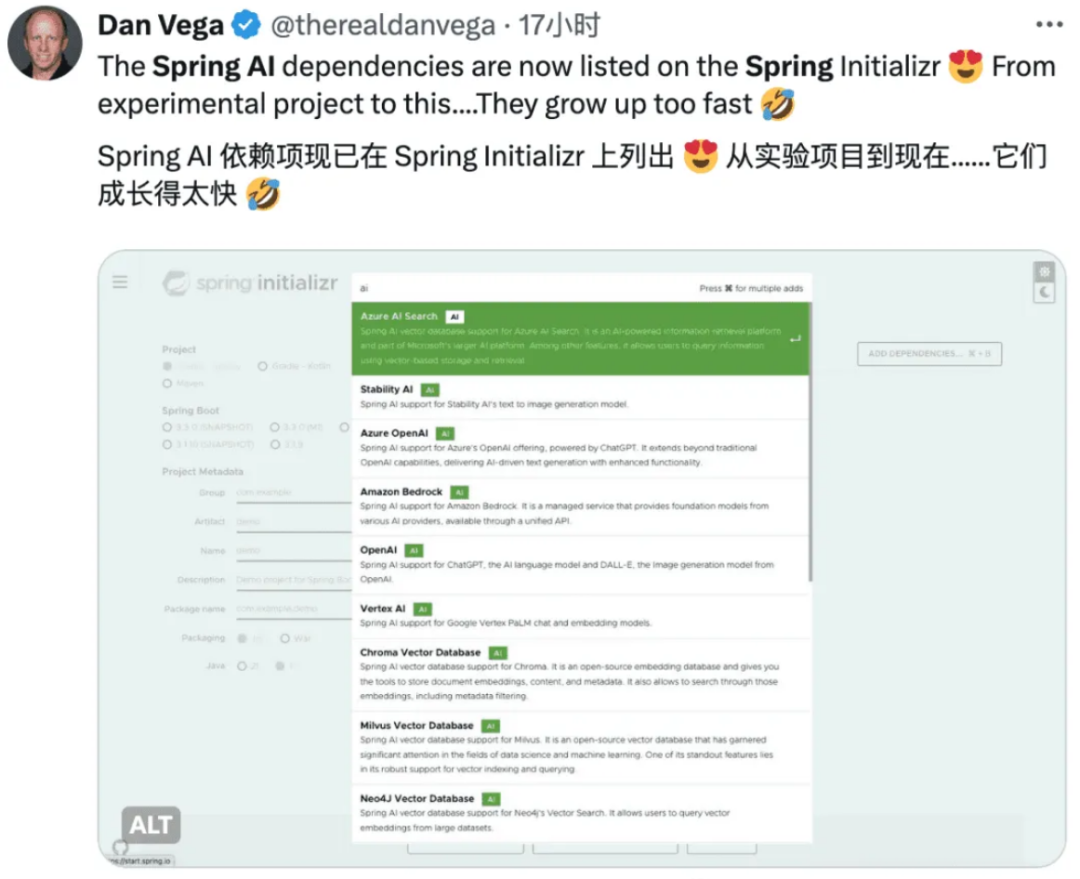
*** —1***—
Spring AI 开发框架设计理念
Spring AI 是一个 AI 工程师的应用框架,它提供了一个友好的 API 和开发 AI 应用的抽象,旨在简化 AI 大模型应用的开发工作。
Spring AI 吸取了知名 Python 项目的精髓,比如:LangChain 和 LlamaIndex。Spring AI 是基于这样一个理念创立的:未来的 AI 大模型应用将不仅限于 Python 开发者,而且会普及到多种编程语言中。Spring AI 的核心是提供了开发 AI 大模型应用所需的基本抽象模型,这些抽象拥有多种实现方式,使得开发者可以用很少的代码改动就能实现组件的轻松替换。
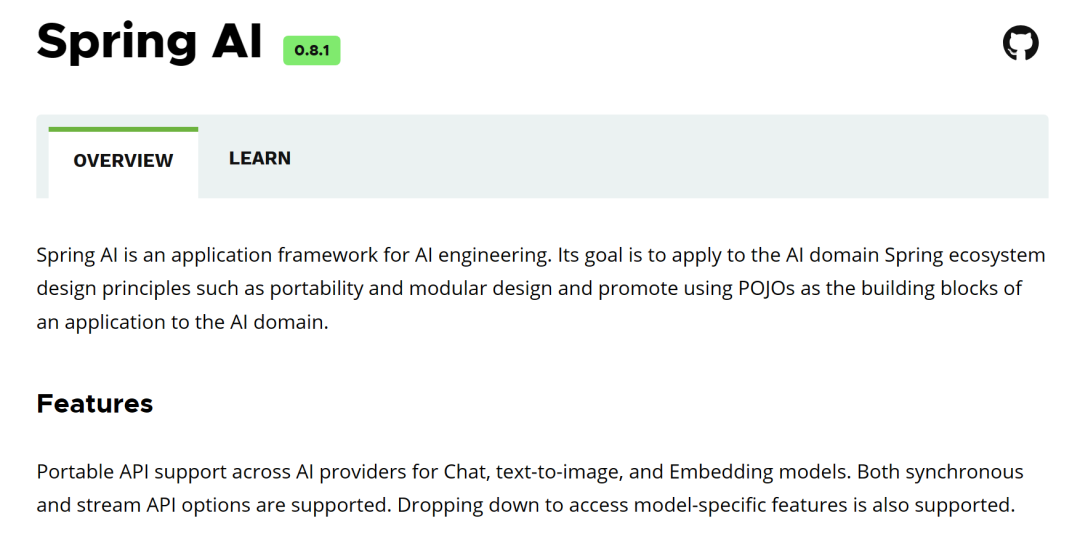
Spring AI 主要功能特性如下:
第一、对主流 AI 大模型供应商提供了支持,比如:OpenAI、Microsoft、Amazon、Google HuggingFace、Ollama、MistralAI 支持,目前对国内大模型支持还不友好。
第二、支持 AI 大模型类型包括:聊天、文本到图像、文本到声音,比如:OpenAI with DALL-E、StabilityAI 等。
第三、支持主流的 Embedding Model 和向量数据库,比如:Azure Vector Search、Chroma、Milvus、Neo4j、PostgreSQL/PGVector、PineCone、Redis 等。
第四、把 AI 大模型输出映射到简单的 Java 对象(POJOs)上。
第五、支持了函数调用(Function calling)功能。
第六、为数据工程提供 ETL(数据抽取、转换和加载)框架。
第七、支持 Spring Boot 自动配置和快速启动,便于运行 AI 模型和管理向量库。
当前,Spring AI 最新版本为 0.8.1,具体使用也比较简单,符合 Java 开发者的开发习惯。
更详细的特性在这里:https://spring.io/projects/spring-ai
*** —2***—
Spring AI 应用开发案例
接下来我们来看3个具体的开发案例,Spring AI 最新版本为 0.8.1,具体使用也比较简单,符合 Java 开发者的开发习惯。
案例一:基于大模型的对话应用开发
package org.springframework.ai.openai.samples.helloworld.simple;
import org.springframework.ai.chat.ChatClient;
import org.springframework.beans.factory.annotation.Autowired;
import org.springframework.web.bind.annotation.GetMapping;
import org.springframework.web.bind.annotation.RequestParam;
import org.springframework.web.bind.annotation.RestController;
import java.util.Map;
@RestController
public class SimpleAiController {
private final ChatClient chatClient;
@Autowired
public SimpleAiController(ChatClient chatClient) {
this.chatClient = chatClient;
}
@GetMapping("/ai/simple")
public Map<String, String> completion(@RequestParam(value = "message", defaultValue = "Tell me a joke") String message) {
return Map.of("generation", chatClient.call(message));
}
}
案例二:RAG 检索增强应用开发
package org.springframework.samples.ai.azure.openai.rag;
import org.slf4j.Logger;
import org.slf4j.LoggerFactory;
import org.springframework.ai.client.AiClient;
import org.springframework.ai.client.AiResponse;
import org.springframework.ai.client.Generation;
import org.springframework.ai.document.Document;
import org.springframework.ai.embedding.EmbeddingClient;
import org.springframework.ai.loader.impl.JsonLoader;
import org.springframework.ai.prompt.Prompt;
import org.springframework.ai.prompt.SystemPromptTemplate;
import org.springframework.ai.prompt.messages.Message;
import org.springframework.ai.prompt.messages.UserMessage;
import org.springframework.ai.retriever.impl.VectorStoreRetriever;
import org.springframework.ai.vectorstore.VectorStore;
import org.springframework.ai.vectorstore.impl.InMemoryVectorStore;
import org.springframework.beans.factory.annotation.Value;
import org.springframework.core.io.Resource;
import java.util.List;
import java.util.Map;
import java.util.stream.Collectors;
public class RagService {
private static final Logger logger = LoggerFactory.getLogger(RagService.class);
@Value("classpath:/data/bikes.json")
private Resource bikesResource;
@Value("classpath:/prompts/system-qa.st")
private Resource systemBikePrompt;
private final AiClient aiClient;
private final EmbeddingClient embeddingClient;
public RagService(AiClient aiClient, EmbeddingClient embeddingClient) {
this.aiClient = aiClient;
this.embeddingClient = embeddingClient;
}
public Generation retrieve(String message) {
// Step 1 - Load JSON document as Documents
logger.info("Loading JSON as Documents");
JsonLoader jsonLoader = new JsonLoader(bikesResource,
"name", "price", "shortDescription", "description");
List<Document> documents = jsonLoader.load();
logger.info("Loading JSON as Documents");
// Step 2 - Create embeddings and save to vector store
logger.info("Creating Embeddings...");
VectorStore vectorStore = new InMemoryVectorStore(embeddingClient);
vectorStore.add(documents);
logger.info("Embeddings created.");
// Step 3 retrieve related documents to query
VectorStoreRetriever vectorStoreRetriever = new VectorStoreRetriever(vectorStore);
logger.info("Retrieving relevant documents");
List<Document> similarDocuments = vectorStoreRetriever.retrieve(message);
logger.info(String.format("Found %s relevant documents.", similarDocuments.size()));
// Step 4 Embed documents into SystemMessage with the `system-qa.st` prompt template
Message systemMessage = getSystemMessage(similarDocuments);
UserMessage userMessage = new UserMessage(message);
// Step 4 - Ask the AI model
logger.info("Asking AI model to reply to question.");
Prompt prompt = new Prompt(List.of(systemMessage, userMessage));
logger.info(prompt.toString());
AiResponse response = aiClient.generate(prompt);
logger.info("AI responded.");
logger.info(response.getGeneration().toString());
return response.getGeneration();
}
private Message getSystemMessage(List<Document> similarDocuments) {
String documents = similarDocuments.stream().map(entry -> entry.getContent()).collect(Collectors.joining("\n"));
SystemPromptTemplate systemPromptTemplate = new SystemPromptTemplate(systemBikePrompt);
Message systemMessage = systemPromptTemplate.createMessage(Map.of("documents", documents));
return systemMessage;
}
}
案例三:Function Calling Agent 应用开发
Spring AI Function Calling 函数调用工作流程如下图所示:包含了 Prompt 提示词、大模型、业务服务 API、回调、大模型响应等核心模块。
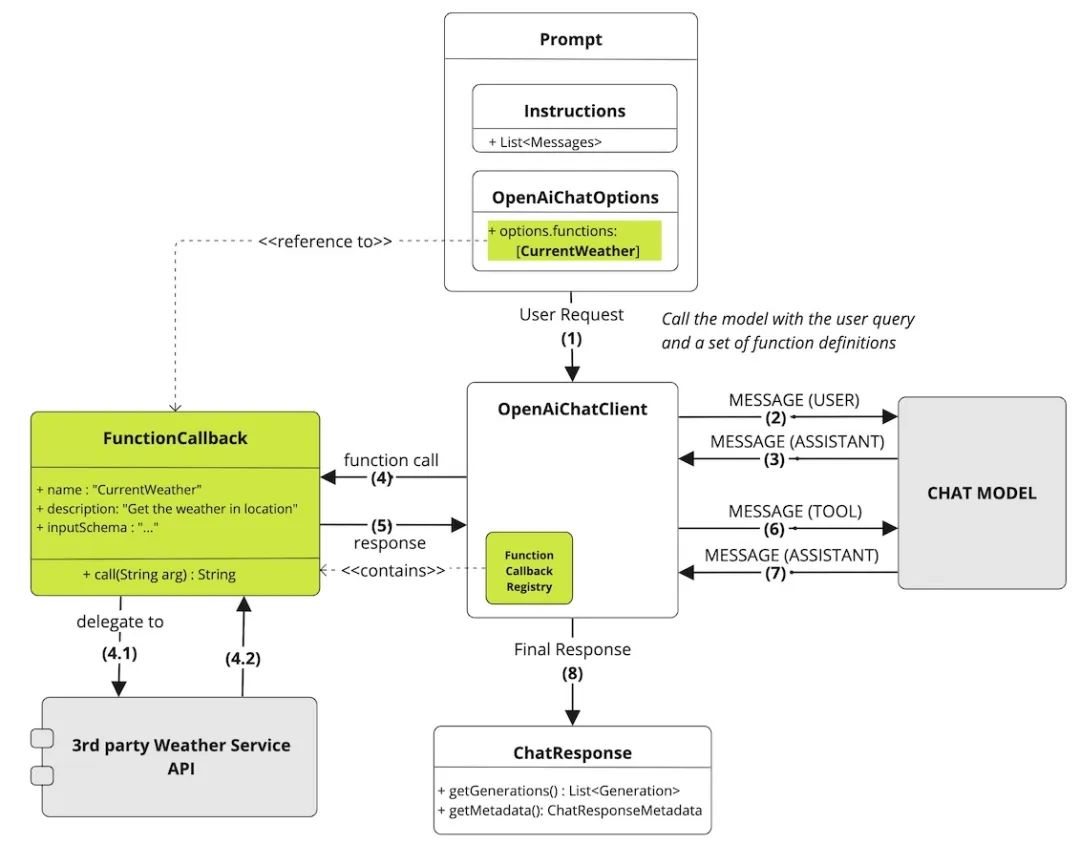
为了帮助同学们彻底掌握大模型的 Agent 智能体、向量数据库、RAG 的应用开发、部署、生产化,今晚20点我会开一场直播和同学们深度剖析,请同学们点击以下预约按钮免费预约。
*** —3***—
!送!****AI大模型开发直播课程
大模型的技术体系非常复杂,即使有了知识图谱和学习路线后,快速掌握并不容易,我们打造了大模型应用技术的系列直播课程,包括:通用大模型技术架构原理、大模型 Agent 应用开发、企业私有大模型开发、向量数据库、大模型应用治理、大模型应用行业落地案例等6项核心技能,帮助同学们快速掌握 AI 大模型的技能。
** 🔥即将开播 **
立即扫码,即可免费****预约
进入直播,大佬直播在线答疑!


本期名额有限
高度起始于速度****(手慢无!!)
*** —4***—
**!!再送!!**《AI 大模型技术知识图谱》
最近很多同学在后台留言:“玄姐,AI 大模型技术的知识图谱有没?”、“AI 大模型技术有学习路线吗?”
我们倾心整理了 AI 大模型技术的知识图谱快来领取吧!

这份业界首创知识图谱和学习路线,今天免费送给大家一份!
只需要以下3步操作就可免费领取:
第一步:长按扫码****以下我的视频号:玄姐谈AGI

第二步:扫码后,点击以下关注按钮,就可关注我。
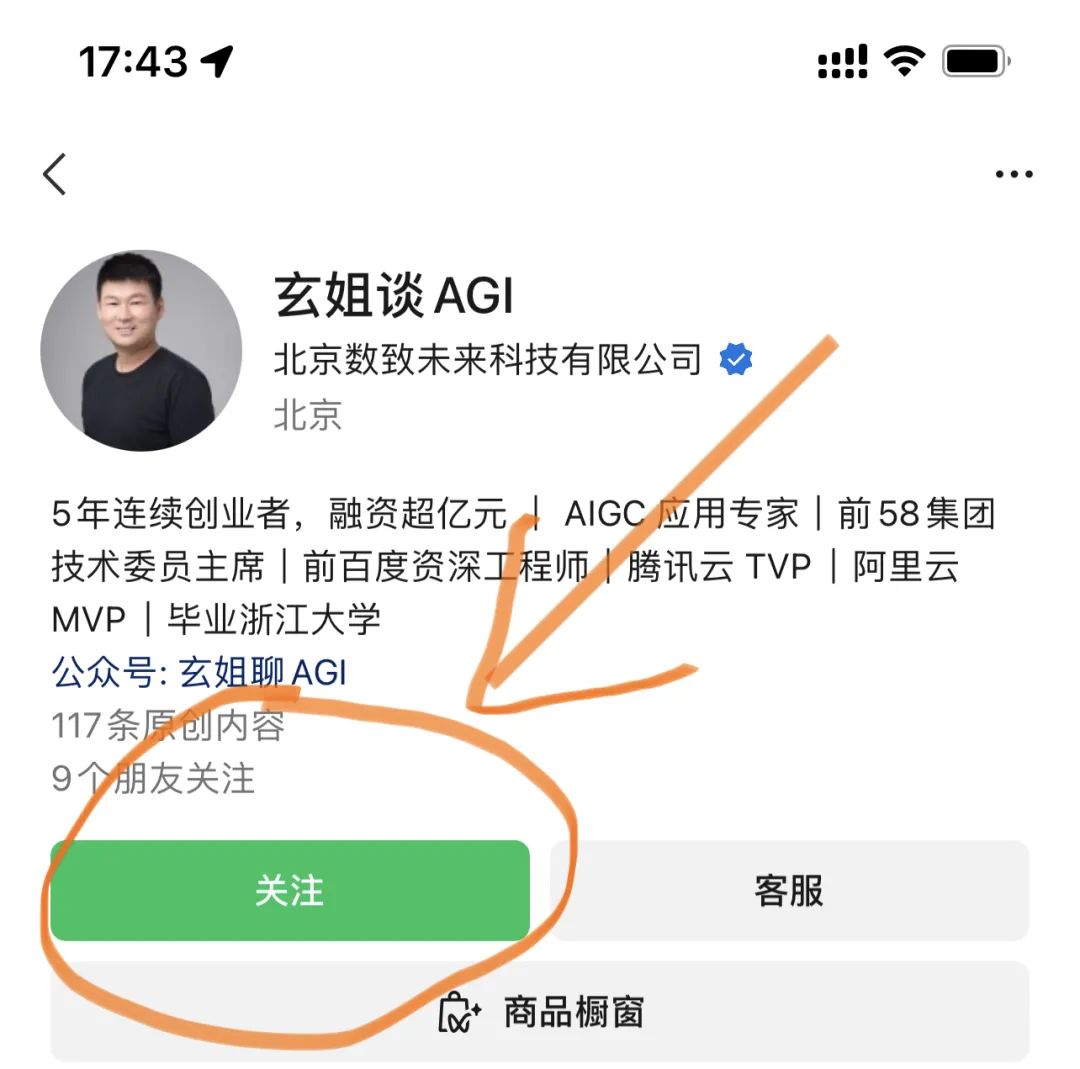
第三步:点击"客服“按钮,回复“知识图谱”即可领取。
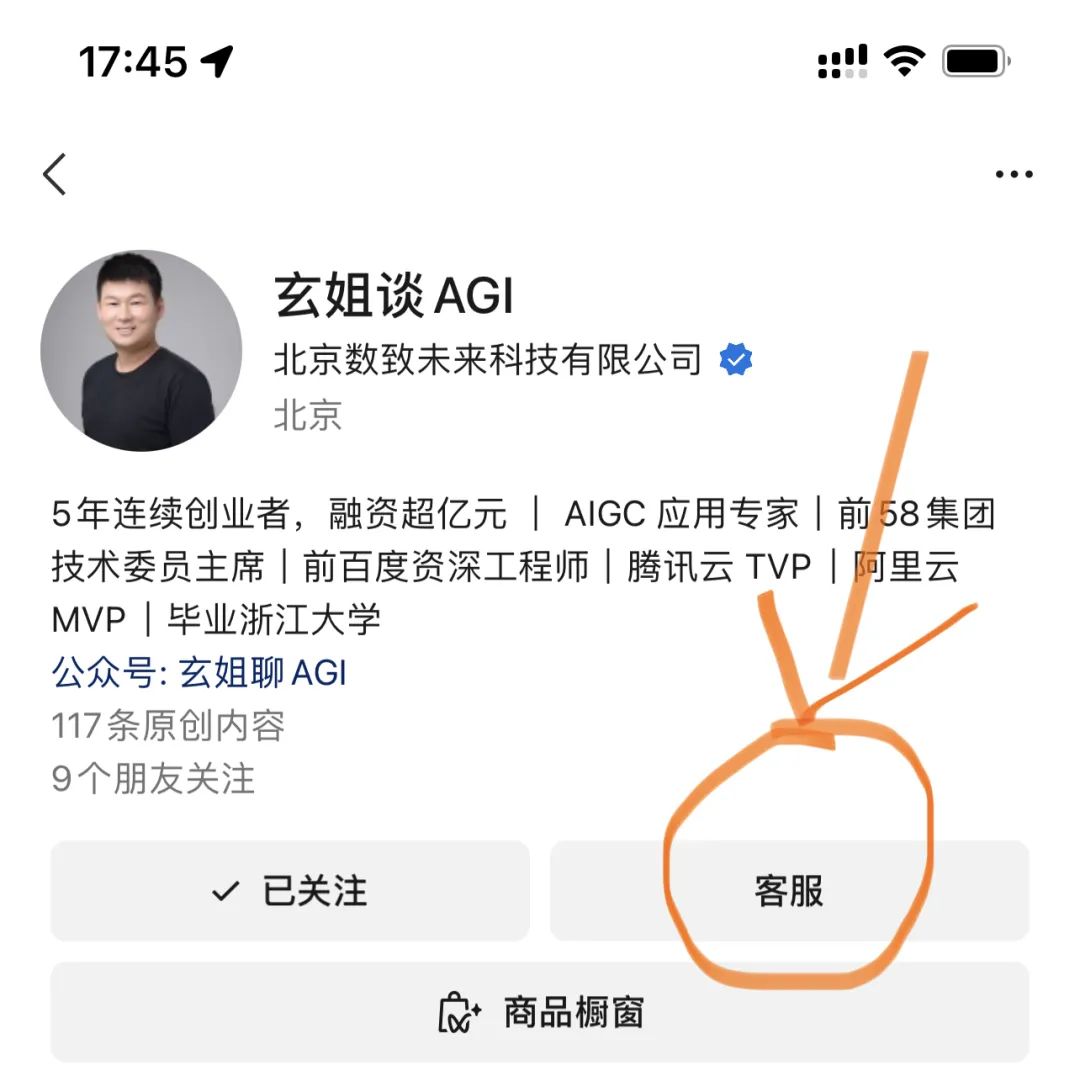
END
版权归原作者 musicml 所有, 如有侵权,请联系我们删除。